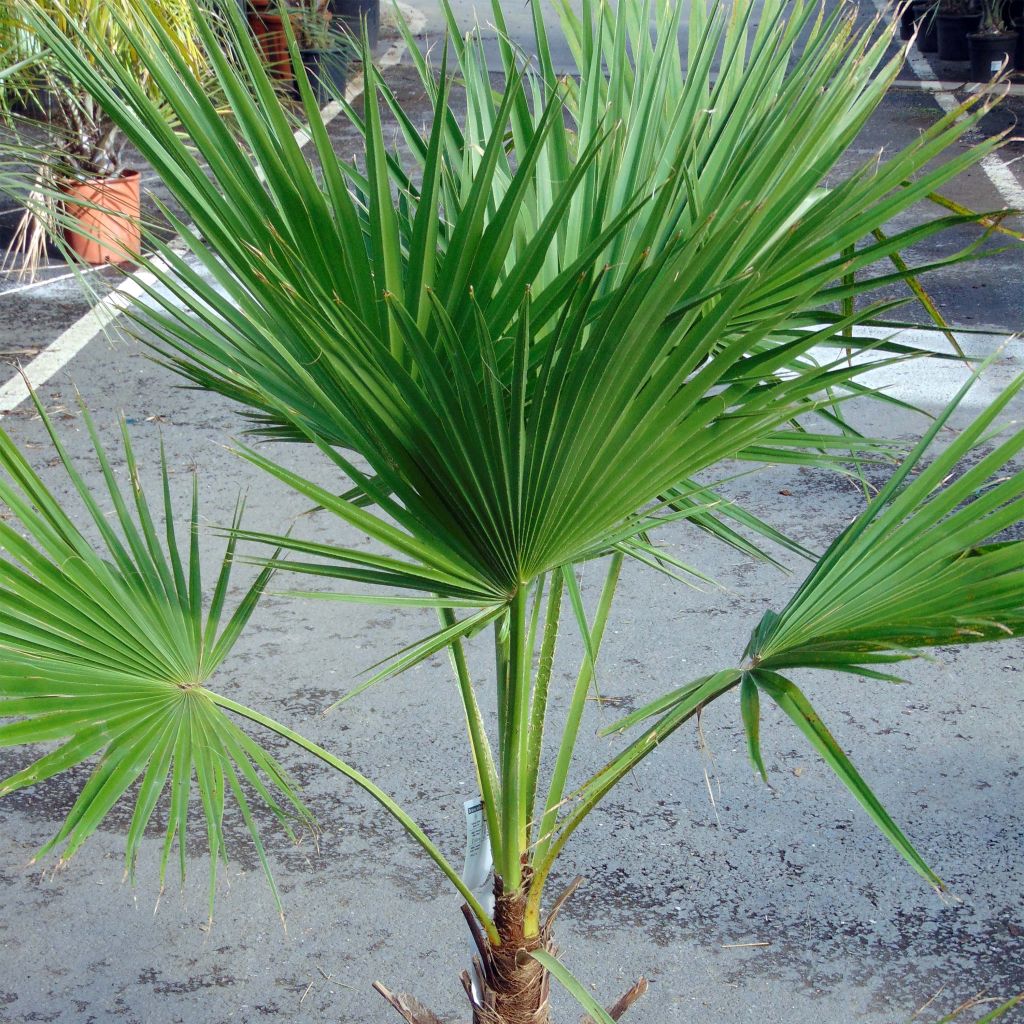

Palmier du Mexique - Brahea edulis
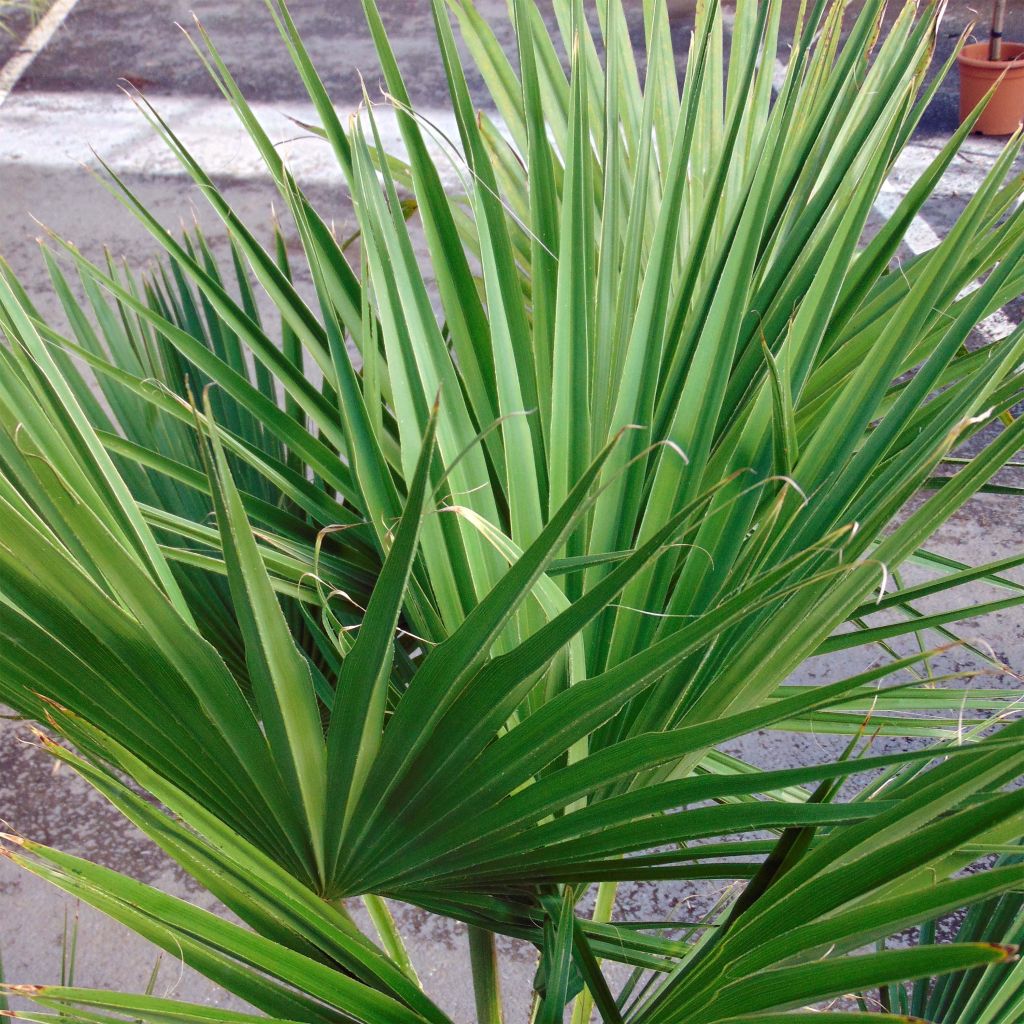

Palmier du Mexique - Brahea edulis
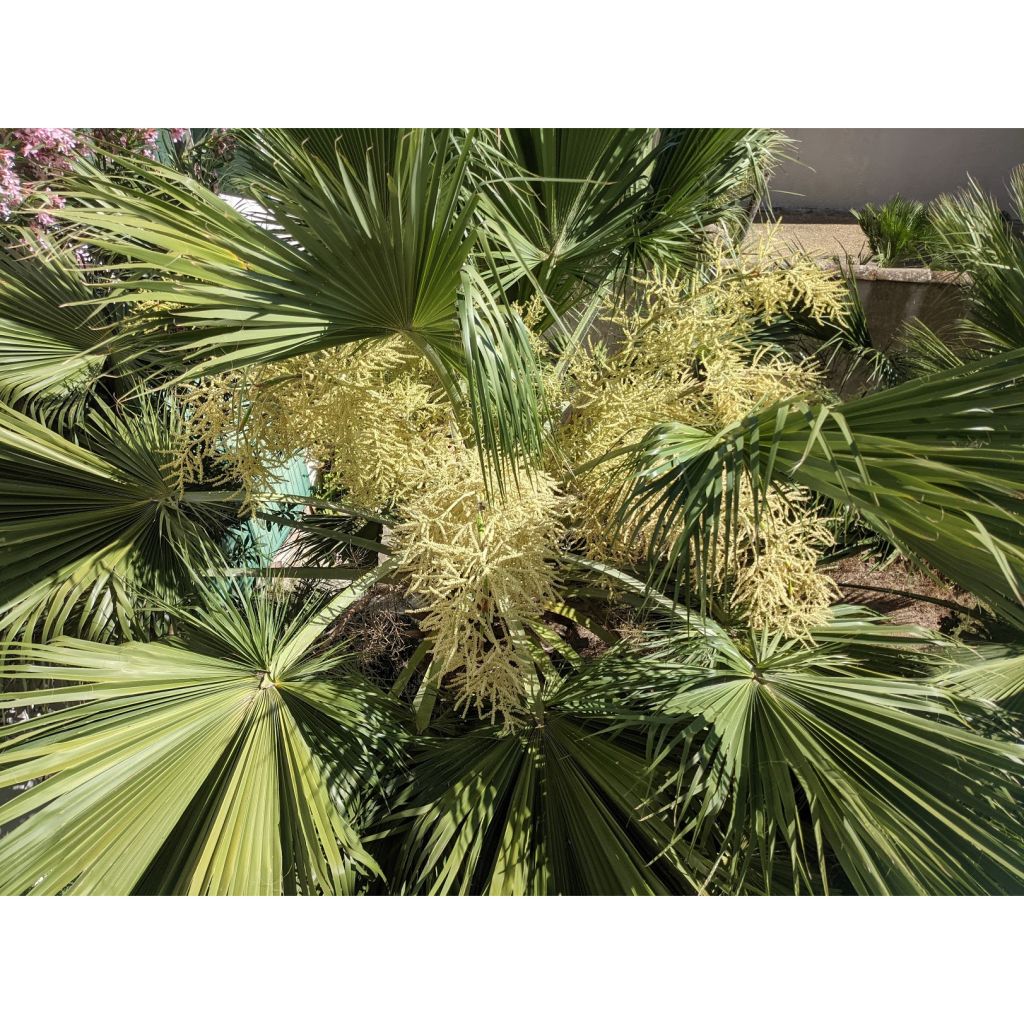

Brahea edulis - Guadalupe Palm
Brahea edulis - Guadalupe Palm
Brahea edulis
Guadalupe Palm
Special offer!
Receive a €20 voucher for any order over €90 (excluding delivery costs, credit notes, and plastic-free options)!
1- Add your favorite plants to your cart.
2- Once you have reached €90, confirm your order (you can even choose the delivery date!).
3- As soon as your order is shipped, you will receive an email containing your voucher code, valid for 3 months (90 days).
Your voucher is unique and can only be used once, for any order with a minimum value of €20, excluding delivery costs.
Can be combined with other current offers, non-divisible and non-refundable.
This plant carries a 24 months recovery warranty
More information
We guarantee the quality of our plants for a full growing cycle, and will replace at our expense any plant that fails to recover under normal climatic and planting conditions.
Would this plant suit my garden?
Set up your Plantfit profile →
Description
The Mexican Palm, Brahea edulis in Latin, is a botanically close species to Brahea armata but with green palm leaves. It is undoubtedly one of the hardiest and largest palms, capable of withstanding temperatures as low as -10/-12°C (14/10.4°F), or even lower if the soil remains dry in winter. It is appreciated for its presence, as well as its ease of cultivation in our ordinary soils, which are often richer in organic matter. It may take a long time to be able to admire its spectacular inflorescences, followed by edible fruits, but a young specimen will already make a big impact in a large rock garden or in the center of an exotic bed. It is native to the arid areas of Mexico where it has become rare, but it may find refuge in your garden. Provide it with well-drained soil, even dry, a sheltered or even arid exposure, and plenty of sun!
Brahea edulis (synonym Erythea edulis) belongs to the family of Arecaceae. It is also known as the Guadalupe Palm, named after the island located 250 km (155.3mi) off the coast of Baja California, on the West coast of Mexico. There, it is naturally found anchored on rocky slopes and cliffs, surrounded by desert vegetation, up to 1000 meters (3281 feet) above sea level. The goats introduced in 1830, which devastated the local flora, are responsible for the rarity of this botanical species, which is now endangered. This palm, which grows relatively slowly during its first 10 years, then develops more rapidly. It can reach a height of 10 to 12 meters (33 to 39 feet), more or less quickly depending on the growing conditions. It develops a single, thick false trunk (stipe), sometimes reaching a diameter of 40 cm (16in), with gray colour, bearing the remains of dried old leaves. These dry leaves form a kind of gray 'skirt', just like in Washingtonia palms. Its foliage, arranged in a terminal crown, will not exceed 3 meters (10 feet) in width. The stipe, widened at the base, gives rise to 20-30 slightly costapalmate leaves, which means palmate leaves arranged in a fan shape around a central axis. Each leaf, 90 cm (35in) to 1.20 m (4ft) wide, displays a beautiful bright green colour on the upper side. The lower side is slightly glaucous. It is divided into 40 to 60 rigid segments and carried by a green petiole reaching 1 to 1.50 meters (3 to 5 feet) in length, covered with whitish down on the upper side, sometimes bordered by small light brown teeth.
Flowering occurs on specimens over 20 years old. It only occurs outdoors, in summer, in warm climates, in the form of long arched inflorescences nestled in the crown of leaves. The flowers, very numerous, are white to ivory in color and are followed by the formation of countless small round fruits, 3 cm (1in) in diameter, brown and shiny, each containing a smooth and shiny brown to almost black seed. These fresh seeds often germinate 4 to 8 months after sowing.
Highly appreciated as a coastal and mild climate street tree, especially in dry and hot areas, the Mexican Palm is one of the most commonly cultivated ornamental palm species, along with Washingtonia robusta and filifera and Phoenix canariensis worldwide, even in our latitudes. Irreplaceable and prestigious in mild climates, it can also be cultivated elsewhere in a large container, which can be stored in a cool, bright, and well-ventilated room during winter. Planted near an entrance or on either side of a gate, or as a standalone near a swimming pool, it will be magnificent. Like Eucalyptus and tall mimosas, in the background of a bed, it forms a typical backdrop for gardens bordering the Mediterranean or the Atlantic coast in the south of France. Enthusiasts of graphic plants can plant Nolina siberica, Agave ovatifolia, Dasylirion wheeleri, Yucca rigida, and other spectacular succulent plants that are well adapted to arid conditions, alongside it.
Report an error about the product description
Brahea edulis - Guadalupe Palm in pictures
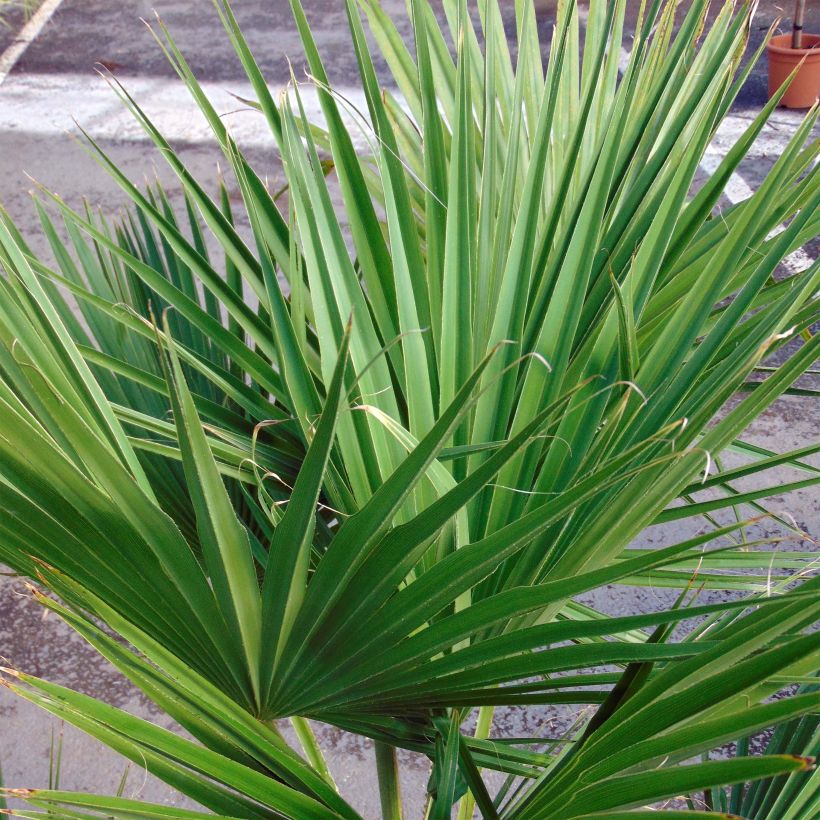

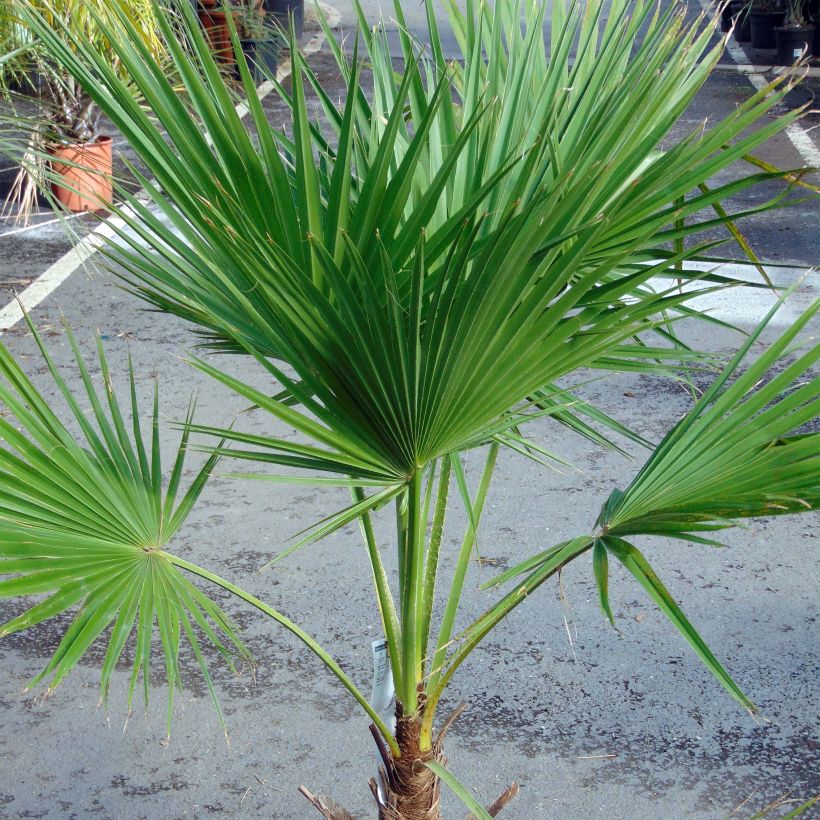

Plant habit
Flowering
Foliage
Botanical data
Brahea
edulis
Arecaceae
Guadalupe Palm
North America
Planting and care
This palm tree shows a fairly slow growth, especially during its young years, and requires sun and heat that will promote faster shoot. Plant Brahea edulis in open ground in mild climates, or in a very large pot in other regions. Install it in well-worked soil, very well drained, even poor and dry on the surface. It tolerates soils richer in organic matter better than its cousin, Brahea armata . It is indifferent to the nature of the soil, but shows a preference for limestone (or alkaline) soils, or excessively limestone (up to a pH of 9.2), like many palm trees originating from arid areas of Mexico. It withstands drought very well once established, but a few copious and spaced waterings will improve its growth and appearance. The ideal is planting in soil that is not too rich, not too clayey, and retains little water: a balanced mixture of coarse sand, gravel, potting soil, and garden soil. Install it in a sunny position and protected from cold and dry winds that it fears. Regularly water the first 3 years, especially if the summer is dry. Easy to grow, it requires little maintenance except for pruning the oldest leaves close to the stem.
In the PACA region, where they are often planted, as well as in the whole south of France and Spain, large palm trees are victims of parasites such as the worm of the formidable and widespread Paysandra archon, a large butterfly that thrives up to England. Specific treatments are now available as a preventive measure. The red palm weevil (Rhynchophorus ferrugineus) has been present in our territory since 2006. The symptoms are: cut, dried or yellowing leaf. These pests attack numerous species of palm trees, with a fatal outcome; the leaves irreparably and completely dry out as soon as the core of the stem hosts larvae.
Planting period
Intended location
Care
This item has not been reviewed yet - be the first to leave a review about it.
Haven't found what you were looking for?
Hardiness is the lowest winter temperature a plant can endure without suffering serious damage or even dying. However, hardiness is affected by location (a sheltered area, such as a patio), protection (winter cover) and soil type (hardiness is improved by well-drained soil).

Photo Sharing Terms & Conditions
In order to encourage gardeners to interact and share their experiences, Promesse de fleurs offers various media enabling content to be uploaded onto its Site - in particular via the ‘Photo sharing’ module.
The User agrees to refrain from:
- Posting any content that is illegal, prejudicial, insulting, racist, inciteful to hatred, revisionist, contrary to public decency, that infringes on privacy or on the privacy rights of third parties, in particular the publicity rights of persons and goods, intellectual property rights, or the right to privacy.
- Submitting content on behalf of a third party;
- Impersonate the identity of a third party and/or publish any personal information about a third party;
In general, the User undertakes to refrain from any unethical behaviour.
All Content (in particular text, comments, files, images, photos, videos, creative works, etc.), which may be subject to property or intellectual property rights, image or other private rights, shall remain the property of the User, subject to the limited rights granted by the terms of the licence granted by Promesse de fleurs as stated below. Users are at liberty to publish or not to publish such Content on the Site, notably via the ‘Photo Sharing’ facility, and accept that this Content shall be made public and freely accessible, notably on the Internet.
Users further acknowledge, undertake to have ,and guarantee that they hold all necessary rights and permissions to publish such material on the Site, in particular with regard to the legislation in force pertaining to any privacy, property, intellectual property, image, or contractual rights, or rights of any other nature. By publishing such Content on the Site, Users acknowledge accepting full liability as publishers of the Content within the meaning of the law, and grant Promesse de fleurs, free of charge, an inclusive, worldwide licence for the said Content for the entire duration of its publication, including all reproduction, representation, up/downloading, displaying, performing, transmission, and storage rights.
Users also grant permission for their name to be linked to the Content and accept that this link may not always be made available.
By engaging in posting material, Users consent to their Content becoming automatically accessible on the Internet, in particular on other sites and/or blogs and/or web pages of the Promesse de fleurs site, including in particular social pages and the Promesse de fleurs catalogue.
Users may secure the removal of entrusted content free of charge by issuing a simple request via our contact form.
The flowering period indicated on our website applies to countries and regions located in USDA zone 8 (France, the United Kingdom, Ireland, the Netherlands, etc.)
It will vary according to where you live:
- In zones 9 to 10 (Italy, Spain, Greece, etc.), flowering will occur about 2 to 4 weeks earlier.
- In zones 6 to 7 (Germany, Poland, Slovenia, and lower mountainous regions), flowering will be delayed by 2 to 3 weeks.
- In zone 5 (Central Europe, Scandinavia), blooming will be delayed by 3 to 5 weeks.
In temperate climates, pruning of spring-flowering shrubs (forsythia, spireas, etc.) should be done just after flowering.
Pruning of summer-flowering shrubs (Indian Lilac, Perovskia, etc.) can be done in winter or spring.
In cold regions as well as with frost-sensitive plants, avoid pruning too early when severe frosts may still occur.
The planting period indicated on our website applies to countries and regions located in USDA zone 8 (France, United Kingdom, Ireland, Netherlands).
It will vary according to where you live:
- In Mediterranean zones (Marseille, Madrid, Milan, etc.), autumn and winter are the best planting periods.
- In continental zones (Strasbourg, Munich, Vienna, etc.), delay planting by 2 to 3 weeks in spring and bring it forward by 2 to 4 weeks in autumn.
- In mountainous regions (the Alps, Pyrenees, Carpathians, etc.), it is best to plant in late spring (May-June) or late summer (August-September).
The harvesting period indicated on our website applies to countries and regions in USDA zone 8 (France, England, Ireland, the Netherlands).
In colder areas (Scandinavia, Poland, Austria...) fruit and vegetable harvests are likely to be delayed by 3-4 weeks.
In warmer areas (Italy, Spain, Greece, etc.), harvesting will probably take place earlier, depending on weather conditions.
The sowing periods indicated on our website apply to countries and regions within USDA Zone 8 (France, UK, Ireland, Netherlands).
In colder areas (Scandinavia, Poland, Austria...), delay any outdoor sowing by 3-4 weeks, or sow under glass.
In warmer climes (Italy, Spain, Greece, etc.), bring outdoor sowing forward by a few weeks.
































